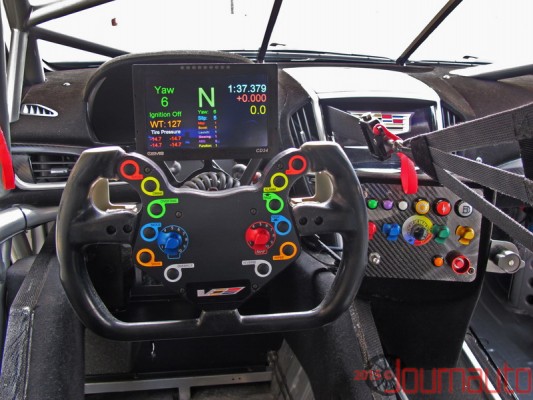Track-Tested to the Driveway _

Just days before the L.A. Auto Show last fall, Cadillac hosted Ignition in Austin, Texas for an exclusive event at the Circuit of the Americas that included a sneak peek at the brand’s latest track weapon – the stunning Cadillac ATS-V.R race car – and hot laps with Johnny O’Connell in his 2014 Pirelli World Challenge championship-winning CTS-V race car on the high-speed F1 track. Not only that, Cadillac had shipped out a small fleet of the outgoing CTS-V models from Michigan to drive on the 5.5-kilometre circuit just so we wouldn’t feel left out.
At some point during my flogging of the whole CTS-V family (coupe, sedan, wagon and even the official Pirelli World Challenge safety car around COTA), it became pretty clear that Cadillac’s V-Series delivers on the promise of being a luxury car that is as much at home on the track as it is on the street.

“That’s our thing,” says Tony Roma, Cadillac’s Chief Engineer for CTS and V-Series, including the ATS-V. “It has been from day one on V-Series. The challenge is how do you make a luxury car that’s still a car you enjoy driving in normal situations?”
I found myself pondering this very question during my hot laps, but since I don’t speak zeros and ones, I asked Roma to try and explain some of the more impressive cool technologies in Cadillac’s current and future high-performance product. He is, after all, responsible for the cars that are in production today, as well as those that are a few years out. He’s also a GM-certified level six development test driver with many laps around the Nürburgring, and is instrumental in setting the flavour and character of these cars.

Shaun: First, can you tell me how the development driver certification works at GM?
TR: Depending on what test you’re running, there’s a certain level of driving certification that we require. If you’re going to run a test… and say “Yes, we’re good!” to the VTS (vehicle technical spec), you need a certain level of driver to go out and exercise the car, because otherwise, you can kind of fool yourself if the driver can’t get everything out of the car. So we’ve come up with a scale of adheres to keep everybody safe and not put people into situations where they might feel stress. We train our people at our proving grounds in Milford. We start on Black Lake or our skid pad and autocross-style drives. Then we move over to our internal road course and we step the cars up. For our highest cert, you’ve got to drive a Z06 Corvette within one per cent of a professional driver’s lap time. And, if you’re going to be what we call a level six driver, you have to put not just one lap, but you have to put out six out of eight laps, which is probably about as hard as it sounds.

Shaun: When we spoke earlier, you mentioned “flying car mode.” It’s not a little button you press to make a Caddy sprout wings and take off, is it?
TR: Flying Car Mode (FCM) is basically an algorithm where it detects that the car has come off the ground – it’s looking at the sensors for the magnetic ride dampers and it detects that the car is off the ground, and it sets all the chassis controls up, knowing that there’s no normal force on the tires so that it recalculates very quickly after the car does land. If you’re in a high grip situation and you’ve just unloaded the car due to some bump or jump in the road, you want it to very quickly learn its way back in. So, FCM is a way that we tell the computers – with the height sensors on each corner – that ‘Hey, I was on a high coefficient of friction surface a second ago, I probably still am when I land.’ It’s petty cool!

At the Nürburgring, Flaunsgarden is one of those spots where you’re coming into this corner really fast, there’s a little hop right before this really fast right-hand turn and you need to use the brakes. You need to either have the forethought to use the brakes before the jump – in most cars, fast cars like this, you need to brake somewhat before the jump – because, if you brake late or if you go over the jump with the brakes on, a traditional ABS algorithm or the chassis control algorithm would assume the low coefficient of friction. It’s a corner like that that really caused us to say ‘Hey, we want to go off and invent this flying car algorithm.’ But then what you find is that you use it in other places – other places around the Nürburgring, other places on our own track in Milford. Like a lot of these technologies, it’s the kind of technology you would use in an evasive maneuver, or if you’re on some back road and there’s some bump or jump. It’s with those kinds of things that these technologies really shine.
It’s when customers don’t even know they need it and it’s there, and the computer is going to say ‘Oh wait, hold on, I know what’s going on.’ Maybe when you’re not even sure what it is.

Shaun: Tell me more about the Brake Knockback Algorithm. I’m pretty sure I felt it both on the road and the track today.
TR: It’s a patented algorithm one of our guys came up with that we debuted in this generation of V that’s in our future cars also. So the computer will say okay, before the person needs the brakes, I’m going to go ahead and apply just a very small amount of pressure and if you’re really, really paying attention, sometimes you can pick it up.
Continue reading my interview with Tony Roma on the IGNITION LUXURY & PERFORMANCE website!

